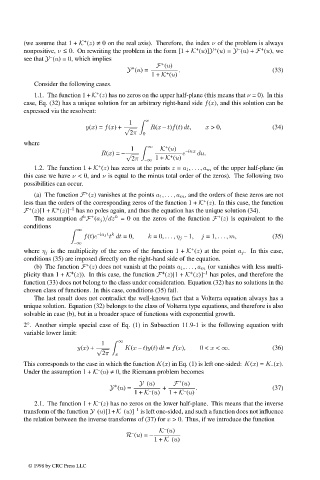Page 576 - Handbook Of Integral Equations
P. 576
+
(we assume that 1 + K (z) ≠ 0 on the real axis). Therefore, the index ν of the problem is always
+
–
+
+
nonpositive, ν ≤ 0. On rewriting the problem in the form [1 + K (u)]Y (u)= Y (u)+ F (u), we
–
see that Y (u) ≡ 0, which implies
+
F (u)
+
Y (u)= . (33)
+
1+ K (u)
Consider the following cases.
+
1.1. The function 1 + K (z) has no zeros on the upper half-plane (this means that ν = 0). In this
case, Eq. (32) has a unique solution for an arbitrary right-hand side f(x), and this solution can be
expressed via the resolvent:
x
1
y(x)= f(x)+ √ R(x – t)f(t) dt, x > 0, (34)
2π 0
where
∞ +
1 K (u) –iux
R(x)= – √ + e du.
2π –∞ 1+ K (u)
+
1.2. The function 1 + K (z) has zeros at the points z = a 1 , ... , a m of the upper half-plane (in
this case we have ν < 0, and ν is equal to the minus total order of the zeros). The following two
possibilities can occur.
+
(a) The function F (z) vanishes at the points a 1 , ... , a m , and the orders of these zeros are not
+
less than the orders of the corresponding zeros of the function 1 + K (z). In this case, the function
+
+
F (z)[1 + K (z)] –1 has no poles again, and thus the equation has the unique solution (34).
k
+
+
k
The assumption d F (a j )/dz = 0 on the zeros of the function F (z) is equivalent to the
conditions
∞
t dt =0,
f(t)e –ia j t k k =0, ... , η j – 1, j =1, ... , m, (35)
–∞
+
where η j is the multiplicity of the zero of the function 1 + K (z) at the point a j . In this case,
conditions (35) are imposed directly on the right-hand side of the equation.
+
(b) The function F (z) does not vanish at the points a 1 , ... , a m (or vanishes with less multi-
+
+
+
plicity than 1 + K (z)). In this case, the function F (z)[1 + K (z)] –1 has poles, and therefore the
function (33) does not belong to the class under consideration. Equation (32) has no solutions in the
chosen class of functions. In this case, conditions (35) fail.
The last result does not contradict the well-known fact that a Volterra equation always has a
unique solution. Equation (32) belongs to the class of Volterra type equations, and therefore is also
solvable in case (b), but in a broader space of functions with exponential growth.
2 . Another simple special case of Eq. (1) in Subsection 11.9-1 is the following equation with
◦
variable lower limit:
1 ∞
y(x)+ √ K(x – t)y(t) dt = f(x), 0 < x < ∞. (36)
2π x
This corresponds to the case in which the function K(x) in Eq. (1) is left one-sided: K(x)= K – (x).
–
Under the assumption 1 + K (u) ≠ 0, the Riemann problem becomes
–
+
Y (u) F (u)
+
Y (u)= + . (37)
–
–
1+ K (u) 1+ K (u)
–
2.1. The function 1 + K (z) has no zeros on the lower half-plane. This means that the inverse
–
–
–1
transform of the function Y (u)[1+K (u)] is left one-sided, and such a function does not influence
the relation between the inverse transforms of (37) for x > 0. Thus, if we introduce the function
–
K (u)
–
R (u)= –
–
1+ K (u)
© 1998 by CRC Press LLC
© 1998 by CRC Press LLC
Page 559

